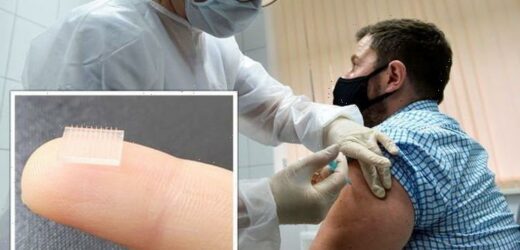91-year-old Margaret Keenan gets her Covid-19 booster vaccine
We use your sign-up to provide content in ways you’ve consented to and to improve our understanding of you. This may include adverts from us and 3rd parties based on our understanding. You can unsubscribe at any time. More info
The 3D printed microneedle patch was developed by researchers from Stanford University and the University of North Carolina at Chapel Hill. Made of polymer, their creation is one square centimetre in size and contains 100 tiny needles. The needles are 700 micrometres long, just barely long enough to penetrate the skin and deliver the vaccine.
When tested on mice, the researchers say they found that the vaccine patch generated an antibody response that was 20 times higher than a traditional needle shot after three weeks and 50 times higher after a month.
Their paper reads: “Using model vaccine components, we demonstrated that 3D-printed microneedle delivery resulted in enhanced cargo retention in the skin, activation of immune cells, and more potent humoral and cellular immune responses as compared with traditional vaccination routes.”
The technology has been available for years, but has proven difficult difficult to successfully manufacture at scale.
The new research, published in the journal Proceedings of the National Academy of Sciences, overcomes those problems with an advanced 3D-printing technique called continuous liquid interface production or CLIP.


This uses ultraviolet light and a special resin to create patches that are consistent in size, shape, and needle spacing, no matter how many are made.
Microbiologist Shaomin Tian said: “Our approach allows us to directly 3D-print the microneedles, which gives us lots of design latitude for making the best microneedles from a performance and cost point-of-view.”
The experts say they could be produced on a commercial scale.
While avoiding the anxiety and pain of a conventional needle, researchers say they can be self-administered.
This is because the short needles only have to penetrate just below the surface layer of the skin.

Needle shots typically bypass the skin and are instead injected into the muscle or the subcutaneous space, which refers to the layer of tissue underneath the skin.
But because the skin is rich in immune cells, vaccines delivered into the skin cells, known as intradermal vaccination, often have improved efficacy, researchers say.
However, intradermal vaccination is difficult to administer with traditional needles and can be painful for the recipient.
Researchers hope their new prototype could provide a solution and also help reduce vaccine hesitancy for people who suffer from needle phobia.
DON’T MISS
Germany faces worse gas crisis as Britain outsmarts Putin [INSIGHT]
Brexit Britain win as Blackstone to create 2,700 UK jobs [REPORT]
Ukraine and Hungary summon ambassadors over Russian gas [REVEAL]


The team says that its design and approach can be adapted to cover vaccines for flu, measles, hepatitis, and even COVID-19.
While the patches have yet to be tested on humans, similar benefits should apply as have been seen in mice, enabling faster and more efficient vaccine responses to epidemics and pandemics in the future.
Chemical engineer Joseph DeSimone added: “In developing this technology, we hope to set the foundation for even more rapid global development of vaccines, at lower doses, in a pain and anxiety-free manner.”
Source: Read Full Article


